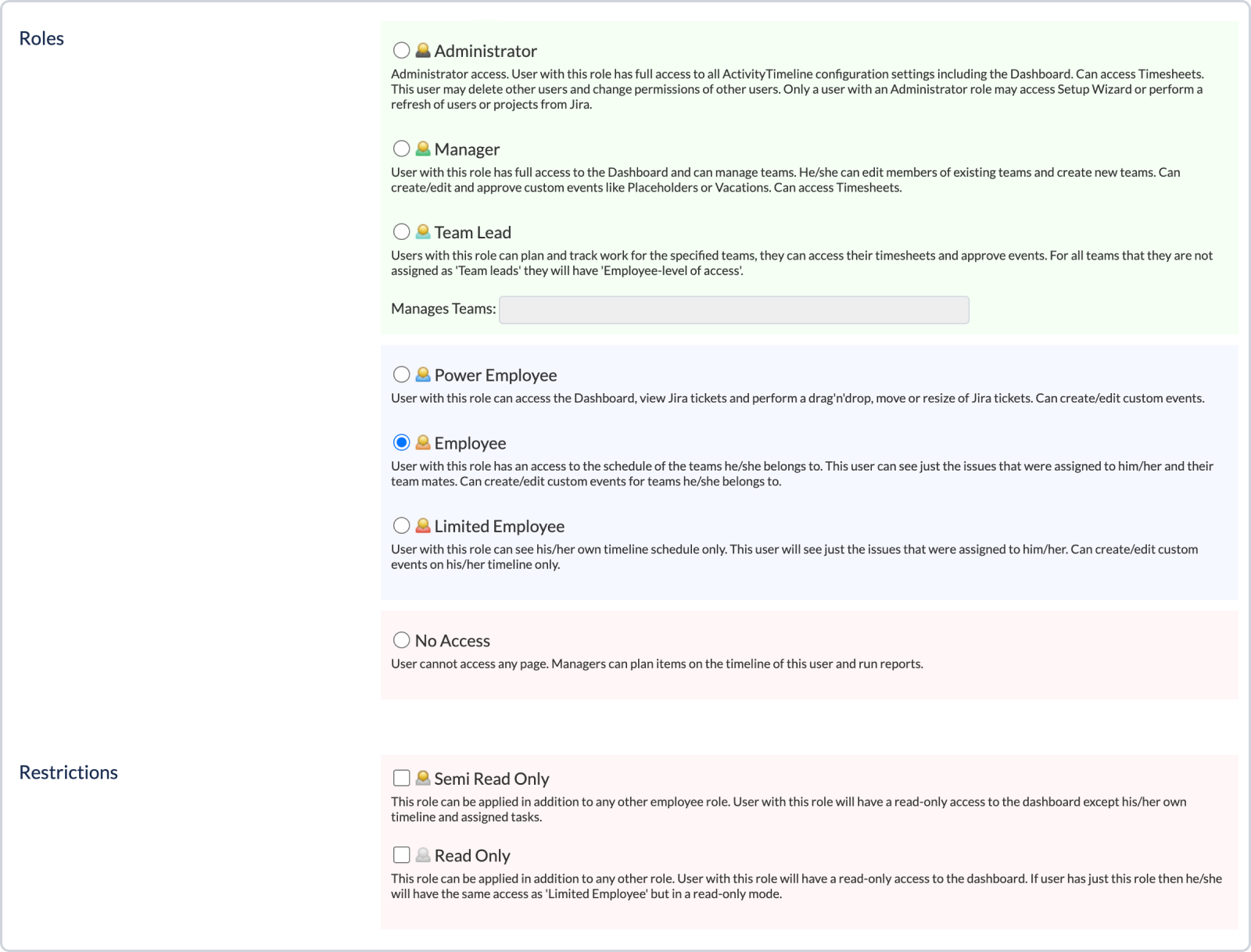Versions Compared
Key
- This line was added.
- This line was removed.
- Formatting was changed.
Permission management in ActivityTimeline is done through User Roles which are separate from Jira permission schemes and govern the visibility and actions of the users of ActivityTimeline.
There are 2 4 ‘Power roles’: Admin & Manager that allow to create and manage teams, generate , Manager, Team Lead, and Power Team Lead allow generating reports and timesheets and assignassigning/approve approving vacations/sick leaves, etc., and 3 ‘Employee’ roles that are assigned to the majority of the users in the organisationorganization.
 Image Removed
Image Removed
Role | Recommended for | Access to Configuration | Access to |
|---|
Modules | Additional permissions |
|---|---|
|
Can create/edit and approve custom events like Placeholders or Vacations. This user may delete other users and change the permissions of other users.
|
Has full access to all ActivityTimeline configuration settings including the Dashboard.
|
|
|
|
|
|
User with this role has full access to the Dashboard and can manage teams.
|
|
|
|
|
|
Senior level employees
Team leads
People who mentor other employees
Can schedule tasks for himself/herself and other team members
Can change statuses of the task
Log work to Jira tasks
Can see schedule for all existing teams on the Dashboard
No Access to Timesheets or reports of other users
|
|
|
|
|
|
|
|
|
|
|
|
|
|
|
|
|
|
|
|
|
Can schedule tasks for himself/herself
Log work to Jira tasks
|
|
|
|
|
|
Only access to personal timeline
Can create new task for himself/herself
Can log time to Jira tasks
|
|
|
Restrictions
Activity Timeline add-on allows assigning different types
of Restrictions appliedof Restrictions in addition to other roles
:.
Restrictions | Access to |
|---|
Modules | Additional Permissions |
|---|---|
|
|
|
|
|
|
|
|
|
|
If a user has just this role then he/she will have the same access as 'Limited Employee' but in a read-only mode.
|
| Info |
|---|
The employee user role is set as a default role for newly added users but you can modify that in Configurations → Synchronization → Refresh Users. |
Team Leads Management
A Team Lead is an additional permission designed to grant users with the Employee or Power Employee role managerial permissions within a specific team while retaining their Employee or Power Employee permissions in other teams. Specifically, a Team Lead will have access to the Timesheets of their Managed Teams and will be able to approve Timesheets and Events for these teams.
Team Leads page, under Configurations → Teams, contains information about the name and position of a Team Lead and the team name.
To view any existing teams that don't have an assigned Team Lead click on the Switch button with the description "Shows Teams without a Team Lead".
 Image Added
Image AddedThis page is designed to view all teams that don't have Team Leads yet. To assign them a Team Lead click on the Assign a Manager button or on the team name, and you'll be redirected to the Edit Team page. Once a Team Manager is assigned, the team is added to the list of teams with managers.
Assigning User Roles
We recommend using the Bulk mode in Configuration → Users to assign roles to users in bulk, which helps avoid manual work. This feature can be changed by Default role for new users in configuration : Synchronization > Refresh Users > Users Settingsalso be used to assign positions and skills.
 Image Added
Image Added Image Added
Image AddedAlternatively, you can use Jira Groups mapping which will be covered in the next modules.
If you do not want someone to access the add-on, you can set their permission level to ‘No Access.’ For the cloud version, they will still see ActivityTimeline in the app's drop-down, but clicking on it will result in an error message. For the DC version, it is possible to configure the display of ActivityTimeline menu on the Jira header to users in some groups only in Configurations → Apps Settings → ActivityTimeline Visibility.
| Info |
|---|
ActivityTimeline offers flexibility in controlling what users can see by reusing Jira permissions alongside its built-in user roles. Two key settings affect this:
Description: This setting determines whether ActivityTimeline should reuse Jira Project Permissions in addition to the built-in ActivityTimeline User Roles. Functionality:
Default Value: Checked (enabled).
Description: This setting determines whether ActivityTimeline should reuse Jira Issue Permissions in addition to the built-in ActivityTimeline User Roles. Functionality:
Default Value: Unchecked (disabled). Important Note: Enabling these settings provides more granular control over what users can see based on their Jira permissions. However, enabling the “Reuse Jira Permissions per Issue” setting may lead to a decrease in dashboard performance due to the additional checks required. By default, “Reuse Jira Permissions per Project” is enabled, and “Reuse Jira Permissions per Issue” is disabled to balance between security and performance. You can configure these settings under the Configurations → Advanced Settings page. |
If you have any additional questions related to the following section, please don’t hesitate to contact our team at: support@reliex.com.
Also, you can check our Quick Start Guide to get started with ActivityTimeline in under 5 minutes.
![]() Frequently Asked Question. Read more.
Frequently Asked Question. Read more.
📰 Helpful tips in our Blog.
📬 Questions? Contacts Us.
🤝 Contact details for Solution partners.
Search doсumentation
| Live Search | ||||
|---|---|---|---|---|
|